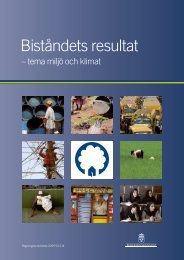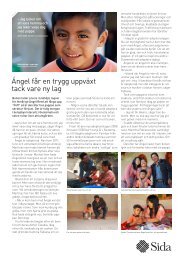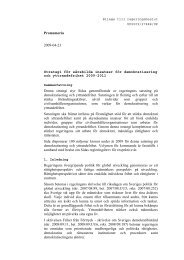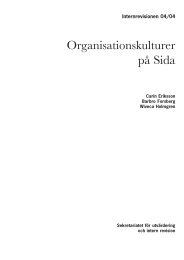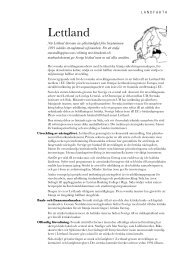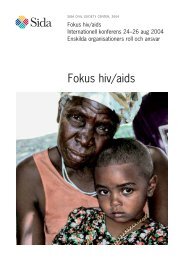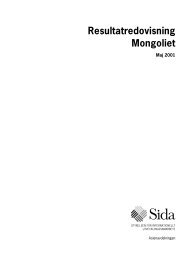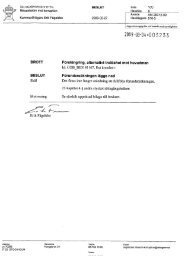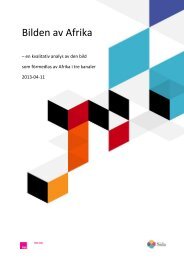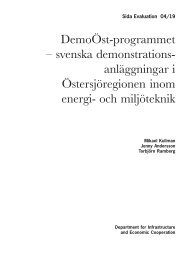Mid-Term Review of the AGIR Programme - Sida
Mid-Term Review of the AGIR Programme - Sida
Mid-Term Review of the AGIR Programme - Sida
Create successful ePaper yourself
Turn your PDF publications into a flip-book with our unique Google optimized e-Paper software.
2 F I N D I N G S<br />
The lack <strong>of</strong> efficient networking among <strong>the</strong>se CSOs also reduces <strong>the</strong> possibility for<br />
synergies between partners’ activities. One <strong>of</strong> <strong>the</strong> reasons for this networking weakness,<br />
mentioned in both programme reports and by some interviewees, is <strong>the</strong> keen<br />
competitiveness over resources by partner organisations, which makes <strong>the</strong>m reluctant<br />
to form or maintain cooperative mechanisms like networks. While this competition<br />
level does seem to be decreasing as <strong>the</strong> programme ages, it does pose a serious problem<br />
for <strong>the</strong> future and development <strong>of</strong> <strong>AGIR</strong> as a cohesive programme with multiple<br />
cooperative CSO partners.<br />
2.4.2 Interaction, Cooperation and Coordination Between <strong>AGIR</strong> INGO Intermediaries<br />
The work <strong>of</strong> <strong>the</strong> <strong>AGIR</strong> programme has been generally successful when <strong>the</strong> results are<br />
gauged by <strong>the</strong> work <strong>of</strong> its CSO partners. What has come to light through <strong>the</strong> mid-term<br />
review however, is that <strong>the</strong> level <strong>of</strong> coordination between <strong>the</strong> intermediaries tempers<br />
this success. Generally, <strong>the</strong>re are inherent barriers to coordination due to <strong>the</strong> different<br />
procedures and policies <strong>of</strong> <strong>the</strong> intermediaries. IBIS, Diakonia and SCC have more<br />
decision autonomy at <strong>the</strong> local level than Oxfam Novib. Beyond this however, <strong>the</strong>re<br />
is a lack <strong>of</strong> shared vision by <strong>the</strong> intermediaries as to what <strong>AGIR</strong> is or could be. When<br />
this topic was raised with <strong>the</strong> intermediaries, <strong>the</strong>re was almost always agreement.<br />
Each expressed, in <strong>the</strong>ir own way, <strong>the</strong> importance <strong>of</strong> <strong>the</strong> ICC (Intermediary Coordination<br />
Committee) and <strong>the</strong> technical group to <strong>the</strong> functioning <strong>of</strong> <strong>the</strong> <strong>AGIR</strong> programme<br />
and its coordination and harmonisation responsibilities (especially in work outside <strong>of</strong><br />
<strong>the</strong> common areas).<br />
At present, <strong>the</strong>re have been varying levels <strong>of</strong> coordination across <strong>the</strong> programme regarding<br />
reporting, shared capacity training activities, and M&E actions. For <strong>the</strong> most<br />
part however, <strong>the</strong> <strong>AGIR</strong> programme still operates in many respects as four separate<br />
projects within a programme structure. For <strong>the</strong> <strong>AGIR</strong> programme to amplify <strong>the</strong> level<br />
<strong>of</strong> success that currently exists, it will be necessary to achieve a higher level <strong>of</strong> coordination<br />
among <strong>the</strong> <strong>AGIR</strong> intermediaries in <strong>the</strong> management <strong>of</strong> <strong>the</strong> programme ‘as a<br />
programme’. While <strong>the</strong> vertical linkages are strong within <strong>the</strong> programme when following<br />
down from individual intermediaries to <strong>the</strong> CSOs with which <strong>the</strong>y work, <strong>the</strong><br />
horizontal linkages are less so. In <strong>the</strong> just-released 2012 semi-annual report, <strong>the</strong> intermediaries<br />
recognise this problem and <strong>the</strong>re has been some movement on increased<br />
coordination when it comes to funding. The intermediaries also comment that more<br />
common or joint activities, which involve CSOs from across <strong>the</strong> different subprogrammes,<br />
will be planned and carried out in <strong>the</strong> future.<br />
Some additional barriers to a programmatic approach continue to surface; that should<br />
be addressed by coordinated work among <strong>the</strong> intermediaries. The existence <strong>of</strong> a comprehensive<br />
M&E system that is consistent across <strong>the</strong> programme is weak. While <strong>the</strong>re<br />
is <strong>the</strong> added complexity <strong>of</strong> <strong>the</strong> intermediaries having to work under <strong>the</strong> goal <strong>of</strong> good<br />
donorship and <strong>the</strong> limitations this can incur on setting overall goals and monitoring<br />
and reporting requirements for individual CSOs within <strong>the</strong> programme, <strong>AGIR</strong> suffers<br />
from reporting in a comprehensive way about its successes as a programme in a way<br />
that is more than <strong>the</strong> collection or sum <strong>of</strong> its individual parts. While recognising that<br />
48




